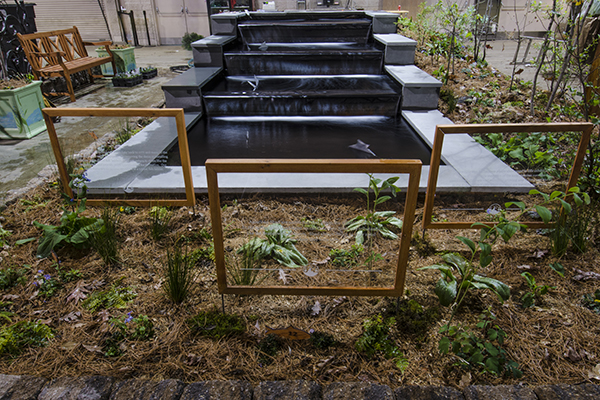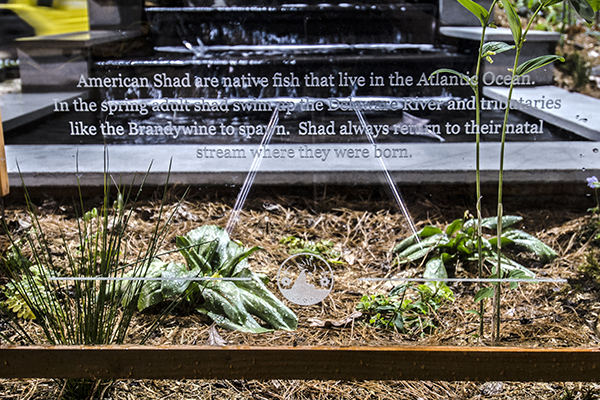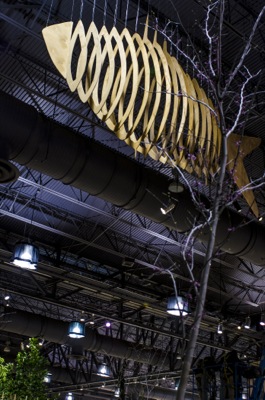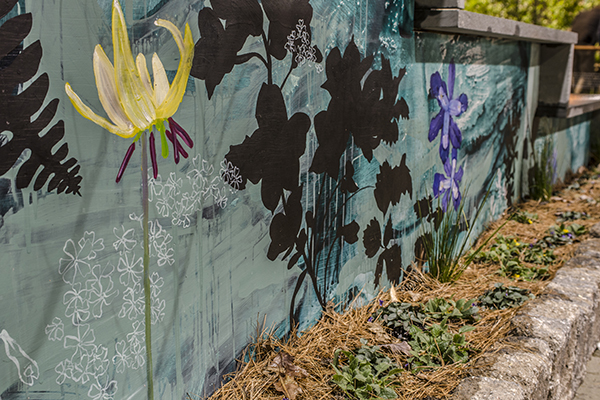


Philly Flower Show
UD class presents award-winning display at Philadelphia Flower Show
1:50 p.m., March 4, 2014--Thanks to an interdisciplinary class and a new registered student organization (RSO), the University of Delaware again has an exhibit at this year’s Philadelphia Flower Show, which runs through March 9 at the Pennsylvania Convention Center. This year’s educational exhibit takes on an ecological theme, specifically the key role of American shad, a fish that once held a prominent place in the Brandywine River but has seen a drastic population decline in recent years.
The project aims to raise public awareness of the issue by helping educate those in attendance on the importance of shad and the ecosystem services they provide to the Brandywine, which supplies the city of Wilmington’s drinking water. The UD group received a “Special Achievement: Best Achievement in Social Change Messaging” award for the display.
Campus Stories
From graduates, faculty
Doctoral hooding
The class is called Design Process Practicum and is taught by Jules Bruck, associate professor in the Department of Plant and Soil Sciences; Anthony Middlebrooks, associate professor in the School of Public Policy and Administration; and Jon Cox, assistant professor in UD’s Department of Art.
The newly formed RSO is called Design and Articulture (DART) and its members — many of whom are also in the class — helped with the creation of this year’s display.
The exhibit examines the Brandywine River and features flowers native to the Brandywine Valley that would naturally grow along its banks in the spring, as well as showing how shad once populated the river in large numbers. “Prior to settlement along the Brandywine we’ve read accounts of the water ‘boiling black’ with shad,” said Bruck, who explained that a lot of the dams along the Brandywine have prevented the shad from swimming upstream.
Some of these dams are historical treasures that can’t be removed — such as the dam at Hagley Museum — and part of the exhibit displays an alternative to dam removal known as a fish ladder. Bruck explained that a fish ladder is one of several techniques that can be used when there is a dam impeding fish trying to upstream.
“A fish ladder has short steps that the fish can flop up and over and get through them pretty easily, and depending on how high the water is, it’s easier at some times than others,” said Bruck, who explained that the group’s version of a fish ladder was a very contemporary version, not a realistic one. “It’s an idea that we just want people to be aware of,” she said.
The reason the group chose to focus on shad is that the fish is important culturally, historically and as indicator species to the relative health of the Brandywine.
Culturally, the shad were once linked to the Brandywine much like blue crab are linked to Baltimore. Middlebrooks explained that Gerald Kauffman, project director for the Water Resources Agency, was a guest speaker at a class session and explained the historical significance of the shad. Kauffman related to the class a story about how Washington’s troops were starving at Valley Forge and the shad migrated north just in time to provide a food supply.
Shad are also a very important indicator species. “Of course we’re interested in the species and their success but as many experts have now told us, shad are very indicative of water quality in the Brandywine watershed, which, of course, supplies all of Wilmington’s drinking water,” said Middlebrooks.
DART
DART is a relatively new RSO and Weber Stibolt, a sophomore in the College of Agriculture and Natural Resources (CANR) and club president, said that its members wanted to form a group to get more recognition for the project. “It’s been kind of an underground project these past couple of years; not a lot of people have known about it.”
Stibolt said that the club has 12 members right now and that his favorite part of working on the project has been learning about aspects of agriculture that he doesn’t get exposed to in his major.
Sydney Bruck, freshman in CANR and member of DART, said the RSO offers students who are in the class now and want to help out with the exhibit next year — but might not have room in their schedule to take the class again — a chance to participate. “If you don’t want to take the class again next year to be involved, you can still be part of the RSO and be involved,” said Bruck.
Bruck also said she enjoyed the interdisciplinary aspect of the project. “I think when you get a bunch of landscape designers together for a flower show, it’s missing something. It’s not complete. Or if you have a bunch of designers or art majors for an art project, it’s still very one sided. But I think we have a very well-rounded exhibit because of all the people, and I think the students really enjoy learning from each other, too.”
Future benefits
Another reason the professors enjoy having the students work on the flower show is that it looks great on their resumes when they apply for future jobs or internships.
Jules Bruck said that a student who worked on the show in the past came to her and said he applied for an internship and the Philadelphia Flower Show project was on his resume. “There’s no doubt in my mind that I got my internship because of the Philadelphia Flower Show. When I got my interview, that’s all they wanted to talk about,” Bruck said the student told her.
Middlebrooks said that the project is “really much more consequential for students long term. It provides yet another opportunity for them to get engaged with professors, get engaged outside the University. They make a variety of connections and I know a number of students have explicitly credited the flower show being on their resume with landing internships, even a Disney internship.”
Middlebrooks also noted that the interdisciplinary and creative aspects of the class help the students in the long run because, in his experience, when people apply for jobs, companies are looking for two main things: creativity and collaboration. “So we’re always looking for ways to really maximize that. And that’s really limited if you just do that in your own discipline, or in a single class, so the flower show has always and continues to serve as an opportunity to cross disciplines,” said Middlebrooks.
Hometown roots
The project is particularly important for Cox who grew up along the Brandywine and said that he remembers playing in the river as a child.
“Some of my earliest memories are actually going down the Brandywine in this little inflatable Sevylor two-person boat with my sister,” said Cox. “So the Brandywine has always been special to me and we go canoeing a couple times a year and we started taking my son there now and he is two and a half now and so he’ll be able to grow up and have some of the same experiences.”
Group effort
Of course, the flower show couldn’t happen without the flowers, and getting the native plants to bloom and look like they would in the spring was no easy feat, especially during such a rough winter.
Bruck was in charge of growing the plants and the students helped out as well. Bruck also thanked Rodney Dempsey, Bill Barts and Joyce Zayakosky, members of the UD Greenhouse staff, for all that they did to get the flowers blooming on time.
The group also thanked the Center for Teaching and Effectiveness and Learning (CTAL), the Office of Undergraduate Research and the Pennsylvania Horticulture Society for help funding the project, and Kauffman and Sherri Evans-Stanton, director of the Brandywine Conservancy, for speaking to the class about the shad.
Article by Adam Thomas
Photos by Jon Cox











